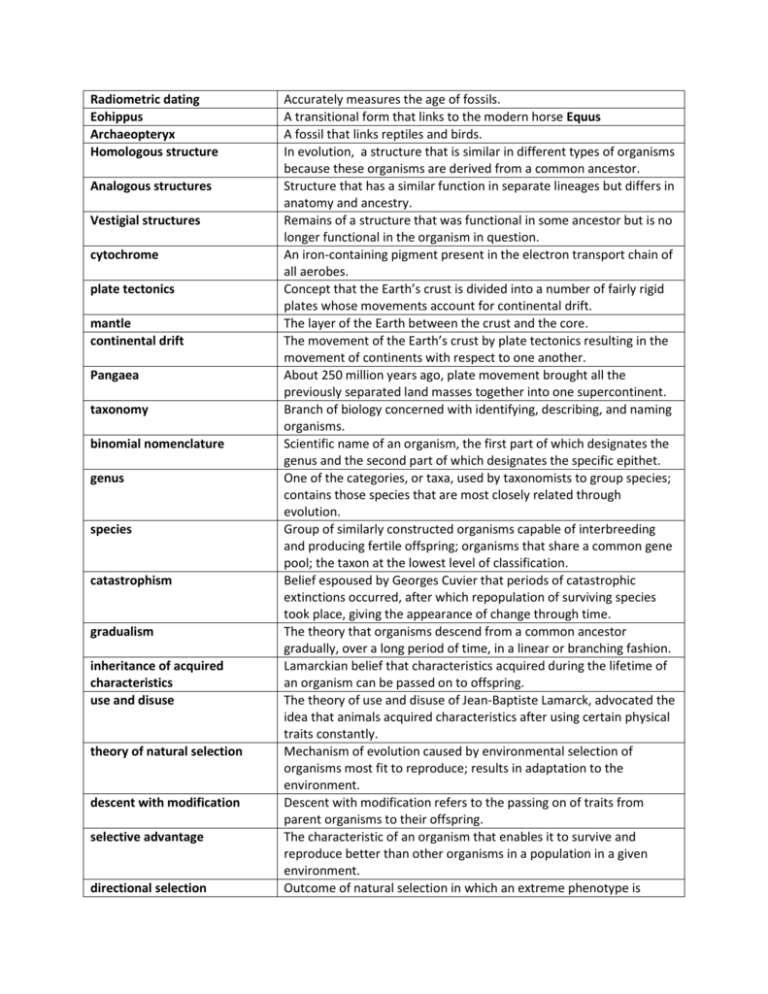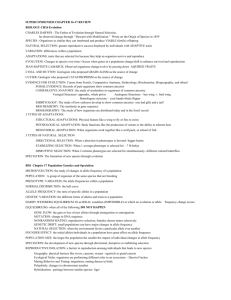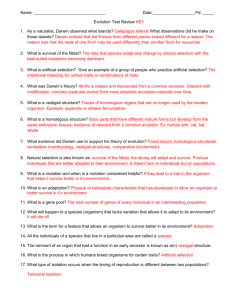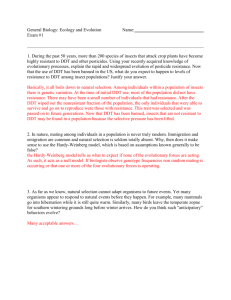BARRON ch 10 VOCAB
advertisement

Radiometric dating Eohippus Archaeopteryx Homologous structure Analogous structures Vestigial structures cytochrome plate tectonics mantle continental drift Pangaea taxonomy binomial nomenclature genus species catastrophism gradualism inheritance of acquired characteristics use and disuse theory of natural selection descent with modification selective advantage directional selection Accurately measures the age of fossils. A transitional form that links to the modern horse Equus A fossil that links reptiles and birds. In evolution, a structure that is similar in different types of organisms because these organisms are derived from a common ancestor. Structure that has a similar function in separate lineages but differs in anatomy and ancestry. Remains of a structure that was functional in some ancestor but is no longer functional in the organism in question. An iron-containing pigment present in the electron transport chain of all aerobes. Concept that the Earth’s crust is divided into a number of fairly rigid plates whose movements account for continental drift. The layer of the Earth between the crust and the core. The movement of the Earth’s crust by plate tectonics resulting in the movement of continents with respect to one another. About 250 million years ago, plate movement brought all the previously separated land masses together into one supercontinent. Branch of biology concerned with identifying, describing, and naming organisms. Scientific name of an organism, the first part of which designates the genus and the second part of which designates the specific epithet. One of the categories, or taxa, used by taxonomists to group species; contains those species that are most closely related through evolution. Group of similarly constructed organisms capable of interbreeding and producing fertile offspring; organisms that share a common gene pool; the taxon at the lowest level of classification. Belief espoused by Georges Cuvier that periods of catastrophic extinctions occurred, after which repopulation of surviving species took place, giving the appearance of change through time. The theory that organisms descend from a common ancestor gradually, over a long period of time, in a linear or branching fashion. Lamarckian belief that characteristics acquired during the lifetime of an organism can be passed on to offspring. The theory of use and disuse of Jean-Baptiste Lamarck, advocated the idea that animals acquired characteristics after using certain physical traits constantly. Mechanism of evolution caused by environmental selection of organisms most fit to reproduce; results in adaptation to the environment. Descent with modification refers to the passing on of traits from parent organisms to their offspring. The characteristic of an organism that enables it to survive and reproduce better than other organisms in a population in a given environment. Outcome of natural selection in which an extreme phenotype is stabilizing/purifying selection sexual selection diversifying/disruptive selection directional selection balanced polymorphism industrial melanism plasmids sexual dimorphism artificial selection balanced polymorphism morph cline independent assortment Crossing-over random fertilization outbreeding Diploidy Heterozygote advantage frequency-dependent selection/ minority advantage search image evolutionary neutral traits evolution favored, usually in a changing environment. Outcome of natural selection in which extreme phenotypes are eliminated and the average phenotype is conserved. Changes in males and females, often due to male competition and female selectivity, leading to increased fitness. Outcome of natural selection in which the two extreme phenotypes are favoured over the average phenotype, leading to more than one distinct form. Selection where one phenotype replaces another in the gene pool. The presence of two or more phenotypically distinct forms of a trait in a single population, such as two varieties of peppered moths, black ones and white ones. Increased frequency of darkly pigmented (melanic) forms in a population when soot and pollution make lightly pigmented forms easier for predators to see against a pigmented background. Extrachromosomal ring of accessory DNA in the cytoplasm of bacteria. Differences in appearance between males and females. Intentional breeding of certain traits, or combinations of traits, over others to produce a desirable outcome. The presence of two or more phenotypically distinct forms of a trait in a single population of a species. A visual or behavioral difference between organisms of distinct populations in a species. A variation in some trait of individuals coordinated with some gradual change in temperature or other factor over a geographic range. Alleles of unlinked genes segregate independently of each other during meiosis so that the gametes contain all possible combinations of alleles. Exchange of segments between nonsister chromatids of a bivalent during meiosis. Random fertilization of one ovum by one sperm out of millions results in enormous variety among the offspring. The mating of organisms within one species that are not closely related. Cell condition in which two of each type of chromosome are present (2n). Situation in which individuals heterozygous for a trait have a selective advantage over those who are homozygous dominant or recessive. Decreases the frequency of the more common phenotypes and increases the frequency of the less common ones. Standard representation of prey developed by predators that enables them to hunt a particular kind of prey effectively. Traits that seem to have no selective advantage. Descent of organisms from common ancestors with the development of genetic and phenotypic changes over time that make them more suited to the environment. genetic drift gene flow mutations non-random mating bottleneck effect founder effect polydactyl stable, nonevolving population dominant allele recessive allele reproductive isolation speciation allopatric speciation sympatric speciation geographic isolation polyploidy habitat isolation behavioral isolation temporal isolation prezygotic barriers postzygotic barriers divergent evolution convergent evolution parallel evolution coevolution Mechanism of evolution due to random changes in the allelic frequencies of a population; more likely to occur in small populations or when only a few individuals of a large population reproduce. Sharing of genes between two populations through interbreeding. Alternation in chromosome structure or number and also an alternation in a gene due to a change in DNA composition. Mating among individuals on the basis of their phenotypic similarities or differences, rather than mating on a random basis. Cause of genetic drift due to colonization by a limited number of individuals who, by chance, have different genotype and allele frequencies than the parent population. Having extra fingers and toes. One in which allelic frequencies do not change. Allele that exerts its phenotypic effect in the heterozygote; it masks the expression of the recessive allele. Allele that exerts its phenotypic effect only in the homozygote; its expression is masked by a dominant allele. One group of genes becomes isolated from another to begin a separate evolutionary history. Origin of new species due to the evolutionary process of descent with modification. Origin of new species between populations that are separated geographically. Origin of new species in populations that overlap geographically. Separation by mountain ranges, canyons, rivers, lakes, glacier, altitude, or longitude. Having a chromosome number that is a multiple greater than twice that of the monoploid number. Two organisms live in the same area but encounter each other rarely. A form of reproductive isolation in which two populations have differences in courtship rituals or other types of behavior that prevent them from interbreeding. Genetic isolation achieved due to temporal (time) differences in breeding. Anatomical or behavioral difference between two species that prevents the possibility of mating. Anatomical or physiological differences between two species that prevents successful reproduction after mating has taken place. Occurs when a population becomes isolated (for any reason) from the rest of the species, becomes exposed to new selective pressures, and evolves into a new species. When unrelated species occupy the same environment, they are subjected to similar selective pressures and show similar adaptions. Two related species that have made similar evolutionary adaptions after their divergence form a common ancestor. Thee reciprocal evolutionary set of adaptions of two interacting adaptive radiation transitional forms punctuated equilibrium endosymbiosis theory histone species. The emergence of numerous species from a common ancestor introduced into an environment. Fossils that exist as evidence of every stage in the evolution of every species with no missing links. A theory that proposes that new species appear suddenly after long periods of stasis. Explanation of the evolution of eukaryotic organelles by phagocytosis of prokaryotes. A group of proteins involved in the forming the nucleosome structure of eukaryote chromatin.









